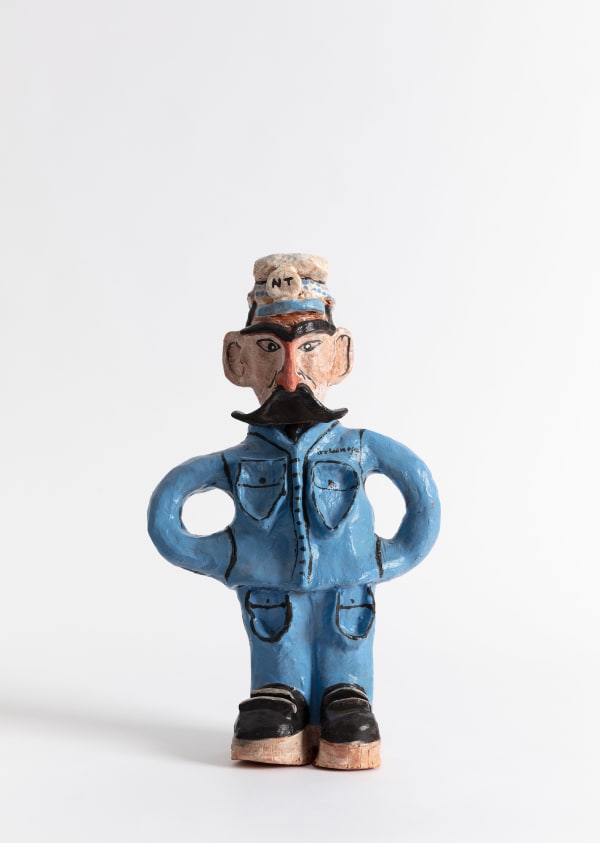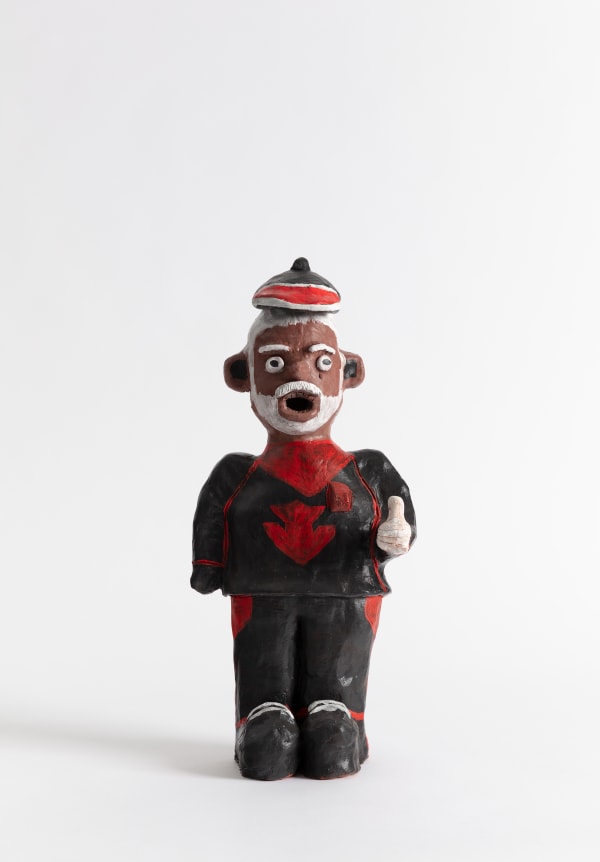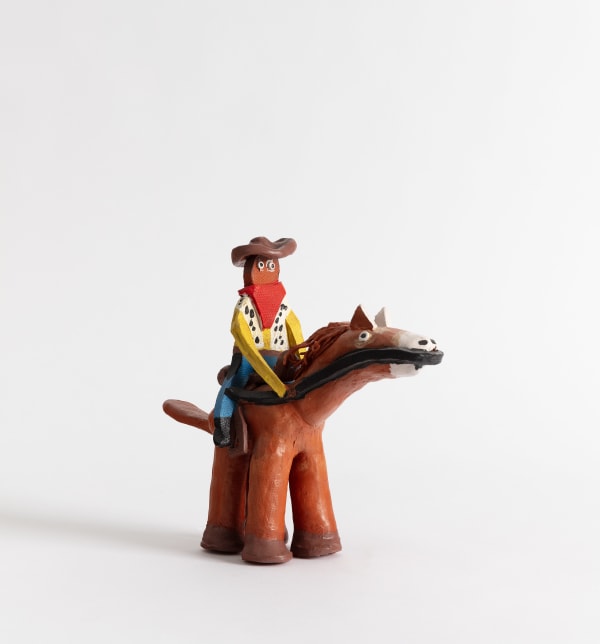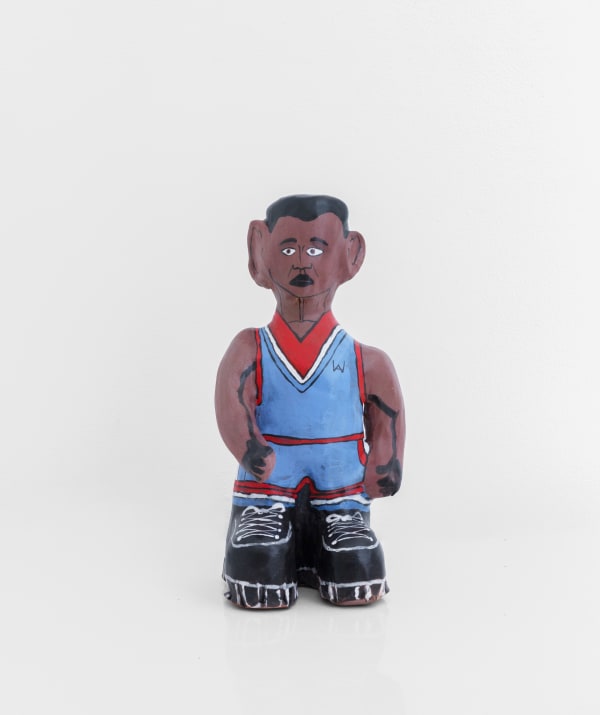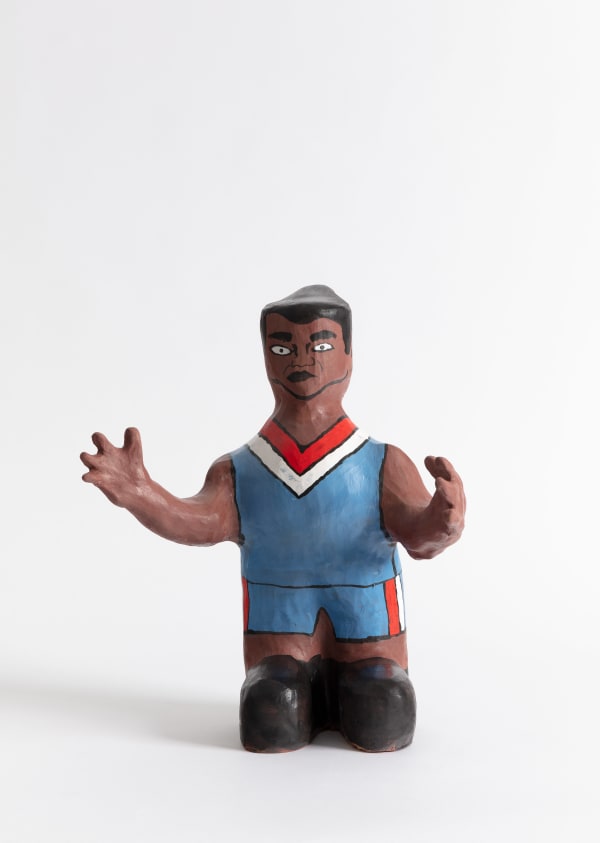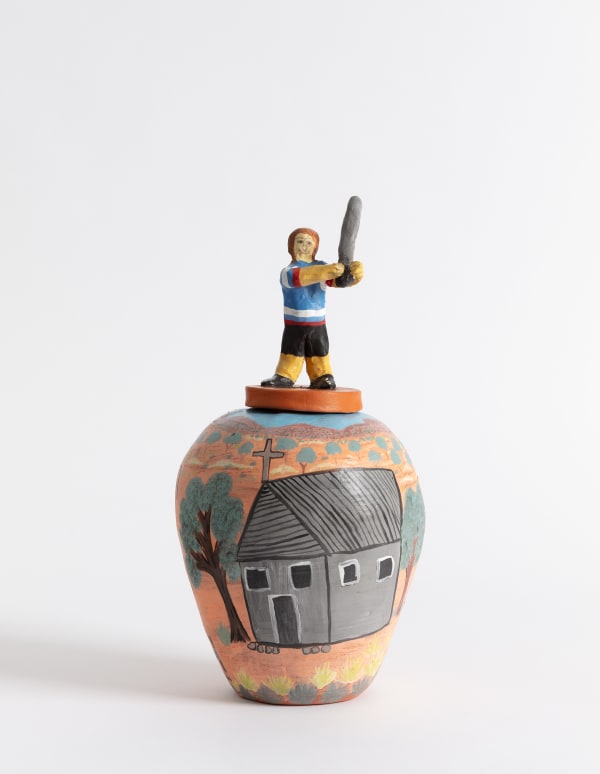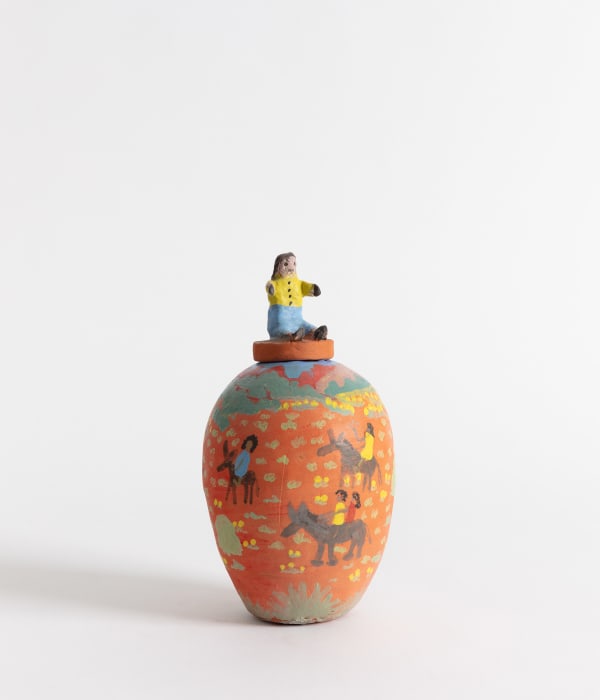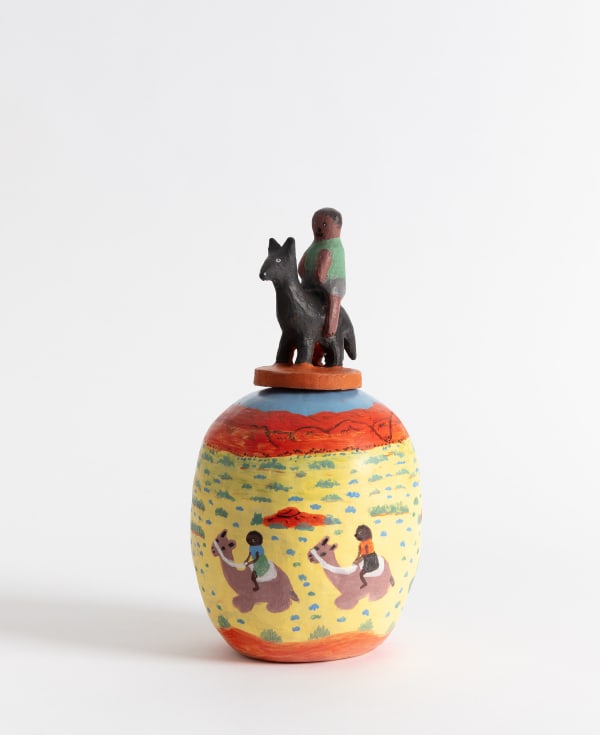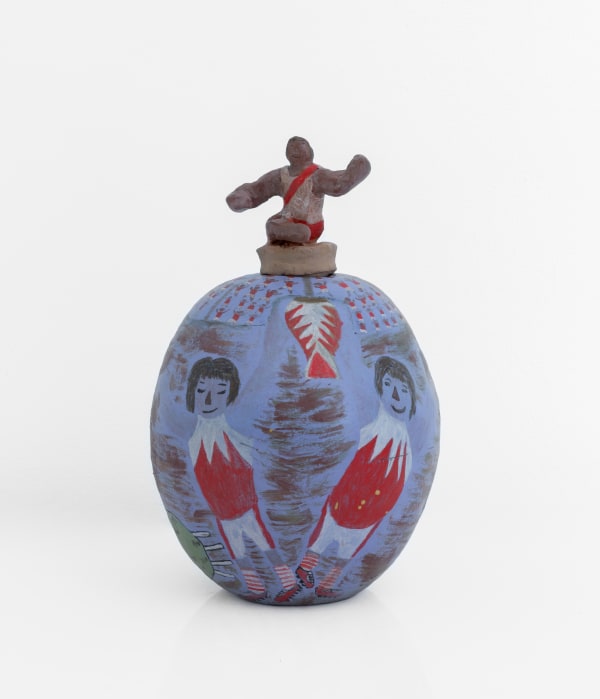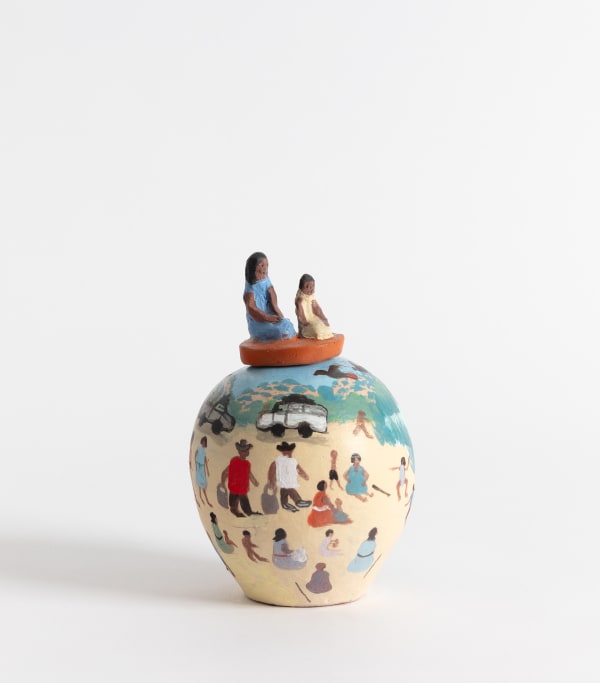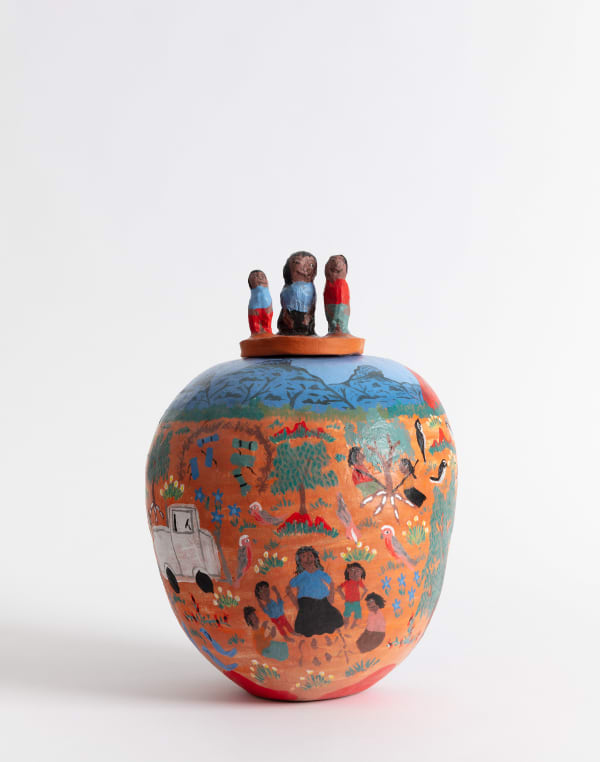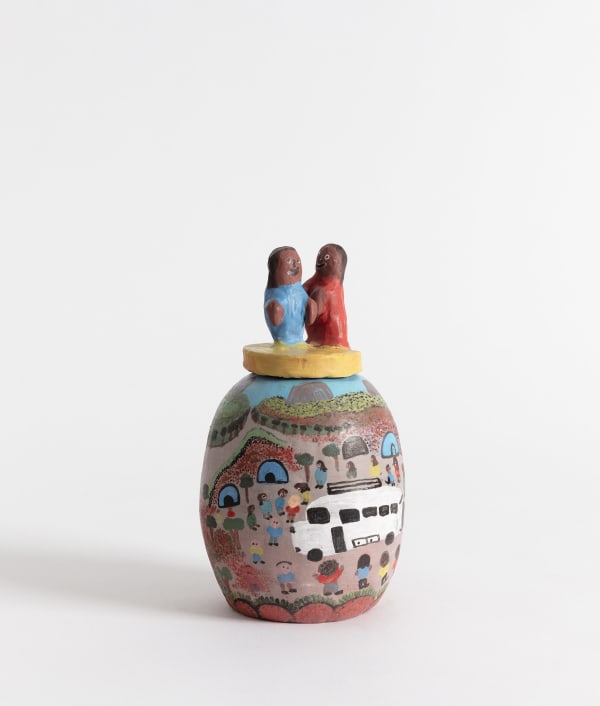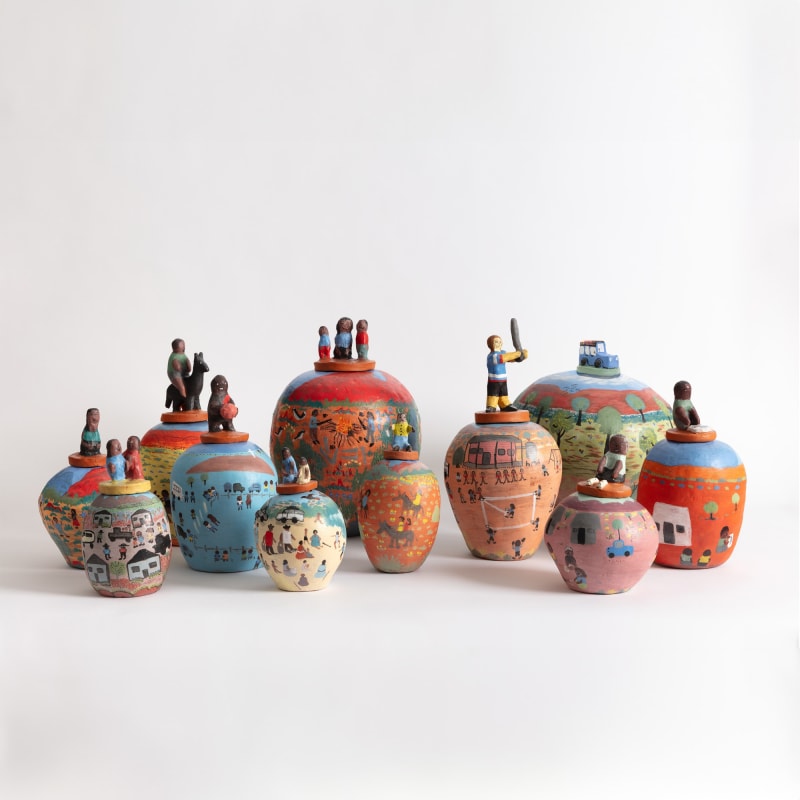Hermannsburg Potters: Rehla Kurrka
-
 Hermannsburg PottersKristoff Ratara – Richard Bell, 2024terracotta and underglazes37 x 27 x 14 cmSold
Hermannsburg PottersKristoff Ratara – Richard Bell, 2024terracotta and underglazes37 x 27 x 14 cmSold -
 Hermannsburg PottersDave Patrick – Ned Kelly, 2024terracotta and underglazes34 x 18 x 15.5 cmSold
Hermannsburg PottersDave Patrick – Ned Kelly, 2024terracotta and underglazes34 x 18 x 15.5 cmSold -
 Hermannsburg PottersAbel Pareoultja – Irrkuntja/Police, 2024terracotta and underglazes38 x 22.5 x 12 cm
Hermannsburg PottersAbel Pareoultja – Irrkuntja/Police, 2024terracotta and underglazes38 x 22.5 x 12 cm -
 Hermannsburg PottersThomas Fishook & Kristoff Ratara – Hitchhiking Man, 2025terracotta and underglazes40.5 x 18.5 x 13 cm
Hermannsburg PottersThomas Fishook & Kristoff Ratara – Hitchhiking Man, 2025terracotta and underglazes40.5 x 18.5 x 13 cm -
 Hermannsburg PottersSammy Ungwanaka – Cowboy Woody, 2024terracotta and underglazes24 x 27 x 10.5 cmSold
Hermannsburg PottersSammy Ungwanaka – Cowboy Woody, 2024terracotta and underglazes24 x 27 x 10.5 cmSold -
 Hermannsburg PottersAbel Pareroultja – Untitled, 2025terracotta and underglazes32 x 16 x 13 cm
Hermannsburg PottersAbel Pareroultja – Untitled, 2025terracotta and underglazes32 x 16 x 13 cm -
 Hermannsburg PottersSammy Ungwanaka – Isaac Heeney, 2025terracotta and underglazes37.5 x 14.5 x 12.5 cmSold
Hermannsburg PottersSammy Ungwanaka – Isaac Heeney, 2025terracotta and underglazes37.5 x 14.5 x 12.5 cmSold -
 Hermannsburg PottersSammy Ungwanaka – Buddy Franklin, 2025terracotta and underglazes34.5 x 14.5 x 12.5 cmSold
Hermannsburg PottersSammy Ungwanaka – Buddy Franklin, 2025terracotta and underglazes34.5 x 14.5 x 12.5 cmSold -
 Hermannsburg PottersAbel Pareoultja – My Brother, 2025terracotta and underglazes36.5 x 29.5 x 22 cm
Hermannsburg PottersAbel Pareoultja – My Brother, 2025terracotta and underglazes36.5 x 29.5 x 22 cm -
 Hermannsburg PottersAlizha Panangka Coulthard – Remote School Softball, 2025terracotta and underglazes33.5 x 16 x 16 cm
Hermannsburg PottersAlizha Panangka Coulthard – Remote School Softball, 2025terracotta and underglazes33.5 x 16 x 16 cm -
 Hermannsburg PottersAnita Mbitjana Ratara – Nanda (Horse), 2025terracotta and underglazes20 x 11.5 x 11.5 cmSold
Hermannsburg PottersAnita Mbitjana Ratara – Nanda (Horse), 2025terracotta and underglazes20 x 11.5 x 11.5 cmSold -
 Hermannsburg PottersJosie Fly – Camping at Karnta-time (cold time), 2025terracotta and underglazes31.5 x 28 x 28 cmSold
Hermannsburg PottersJosie Fly – Camping at Karnta-time (cold time), 2025terracotta and underglazes31.5 x 28 x 28 cmSold -
 Hermannsburg PottersDawn Ngala Wheeler – Down the Creek We Was Riding, 2025terracotta and underglazes29.5 x 16.5 x 16.5 cmSold
Hermannsburg PottersDawn Ngala Wheeler – Down the Creek We Was Riding, 2025terracotta and underglazes29.5 x 16.5 x 16.5 cmSold -
 Hermannsburg PottersAndrew Ebatarinja – Sydney Swans, 2024terracotta and underglazes33 x 22.5 x 22 cm
Hermannsburg PottersAndrew Ebatarinja – Sydney Swans, 2024terracotta and underglazes33 x 22.5 x 22 cm -
 Hermannsburg PottersJudith Pungarta Inkamala – Kwatja Walhama (Swimming in the Water), 2025terracotta and underglazes17 x 12 x 12 cmSold
Hermannsburg PottersJudith Pungarta Inkamala – Kwatja Walhama (Swimming in the Water), 2025terracotta and underglazes17 x 12 x 12 cmSold -
 Hermannsburg PottersDonna Purrula McNamara – Mamama. That Means Special Granma, 2025terracotta and underglazes21 x 14.5 x 14.5 cmSold
Hermannsburg PottersDonna Purrula McNamara – Mamama. That Means Special Granma, 2025terracotta and underglazes21 x 14.5 x 14.5 cmSold -
 Hermannsburg PottersDonna Purrula McNamara – Grandmother Teaching Us, 2025terracotta and underglazes33 x 23 x 24 cm
Hermannsburg PottersDonna Purrula McNamara – Grandmother Teaching Us, 2025terracotta and underglazes33 x 23 x 24 cm -
 Hermannsburg PottersDawn Ngala Wheeler – Albert Namatjira Painting, 2025terracotta and underglazes24.5 x 15 x 15 cmSold
Hermannsburg PottersDawn Ngala Wheeler – Albert Namatjira Painting, 2025terracotta and underglazes24.5 x 15 x 15 cmSold -
 Hermannsburg PottersShirley Wheeler – School Camp at Lilla, 2025terracotta and underglazes19 x 11.5 x 11.5 cmSold
Hermannsburg PottersShirley Wheeler – School Camp at Lilla, 2025terracotta and underglazes19 x 11.5 x 11.5 cmSold -
 Hermannsburg PottersDawn Ngala Wheeler – Ntaria Sports Weekend, 2025terracotta and underglazes25 x 15.5 x 15.5 cm
Hermannsburg PottersDawn Ngala Wheeler – Ntaria Sports Weekend, 2025terracotta and underglazes25 x 15.5 x 15.5 cm -
 Hermannsburg PottersDawn Ngala Wheeler – My Family at Lilla, 2025terracotta and underglazes19 x 14.5 x 14.5 cmSold
Hermannsburg PottersDawn Ngala Wheeler – My Family at Lilla, 2025terracotta and underglazes19 x 14.5 x 14.5 cmSold
Hermannsburg Potters present Relha Kurrka, an exhibition of new ceramic works celebrating the people who shape, sustain, and inspire community, culture, and creativity in Ntaria.
In Western Aranda, the word relha directly translates to “person,” but it holds deeper meaning — often referring specifically to First Nations people. In this context, Relha kurrka carries layered significance: not only are these literal ceramic figures, but they also represent First Nations individuals who hold meaning, memory, and cultural power for the artists and their communities.
In 2024, artist Billy Bain travelled to Ntaria (Hermannsburg) to lead clay workshops with local men, supported by Hermannsburg Potters and Men’s Program worker Abel Pareroultja. A Dharug man from Sydney, Bain’s practice explores the complexities of Aboriginal identity in contemporary Australia, often with sharp humour and political edge. In Ntaria, he invited men of all ages to sculpt someone who had influenced their lives — from grandfathers and cultural leaders to Ned Kelly and Richard Bell.
The workshops were more than a technical training. Abel helped bring the group together and took Bain out on Country to Pmurlangkinya (Palm Valley), where they cooked up some roo tail and spent time around the fire — a moment of cultural sharing and connection. In these spaces, Bain and the Hermannsburg fellas found common ground — different histories and experiences, but a shared sense of identity, responsibility and survival as relha: First Nations men connected through culture, story and place.
This exhibition presents the sculptural works made during and after those workshops — figures full of personality, memory and power. In response, the women of Hermannsburg Potters have created their own versions of relha (people): depicted on their signature hand-coiled pots topped with sculptural lids, each a tribute to those who inspire and sustain their vibrant community.
Together, these works celebrate the legacy and future of one of Central Australia’s most iconic art movements — where clay becomes a medium for storytelling, resistance, connection, and pride.


